Vicinity Centre VCX: Investment Property Accounting Analysis
VerifiedAdded on 2021/06/16
|7
|1834
|36
Report
AI Summary
This report provides a detailed analysis of Vicinity Centre VCX, a real-estate investment trust, focusing on its accounting treatment of investment properties. The report examines the application of AASB 140, which governs the measurement, recognition, and disclosure of investment properties, including freehold and leasehold properties. It details the company's valuation methods, which involve external valuations adjusted for factors like interest rates and rental enhancements, as well as internal valuations. The report further explores the impact of changes in the retail environment on Vicinity Centre VCX's financials, including diminished tenant quality, declining rental income, and decreased capital expenditures. It highlights the decline in segment profit and the increase in lease receivables, along with the impact on key management personnel's compensation. The report references the company's 2017 annual report to support its findings and analysis.
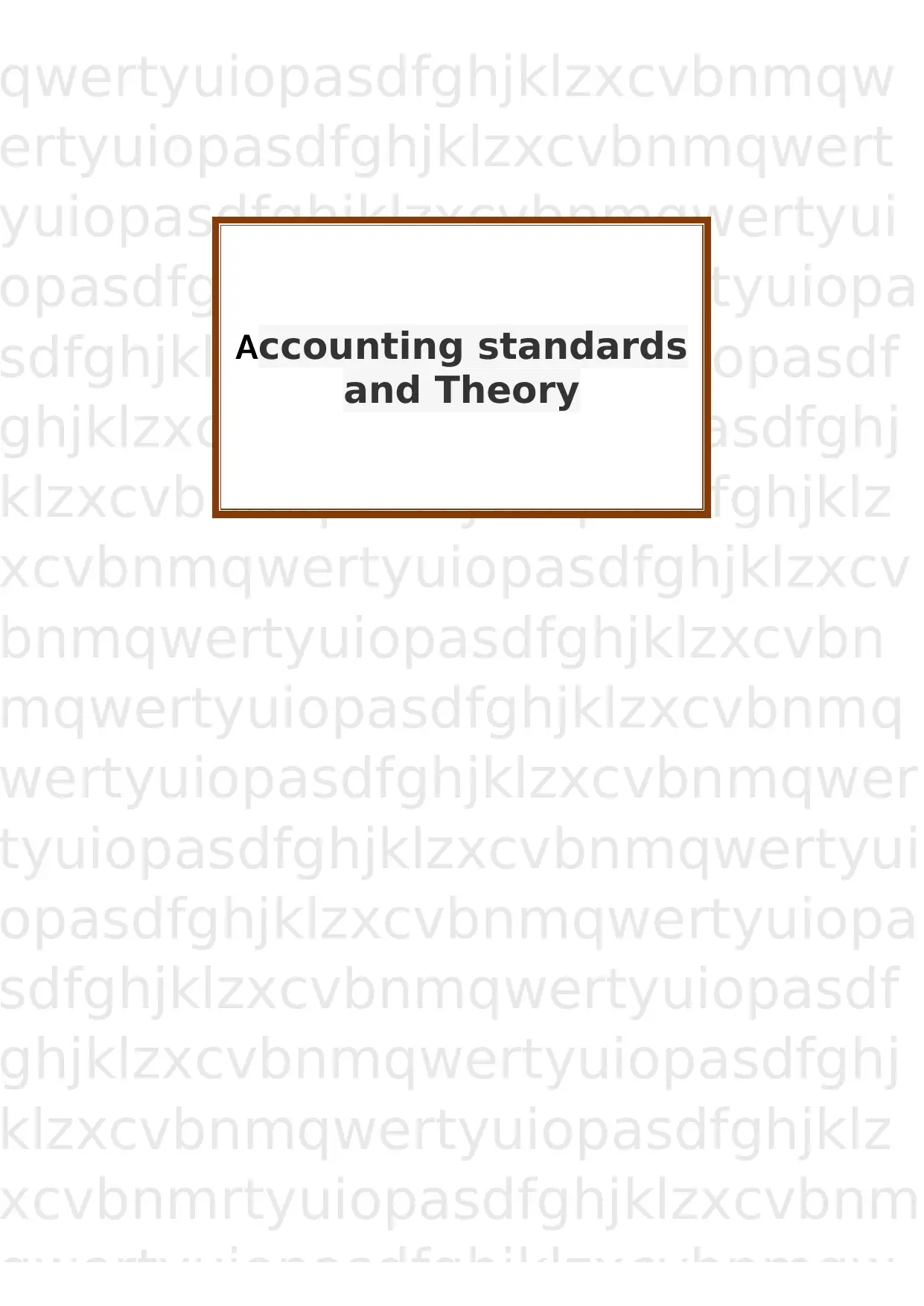
qwertyuiopasdfghjklzxcvbnmqw
ertyuiopasdfghjklzxcvbnmqwert
yuiopasdfghjklzxcvbnmqwertyui
opasdfghjklzxcvbnmqwertyuiopa
sdfghjklzxcvbnmqwertyuiopasdf
ghjklzxcvbnmqwertyuiopasdfghj
klzxcvbnmqwertyuiopasdfghjklz
xcvbnmqwertyuiopasdfghjklzxcv
bnmqwertyuiopasdfghjklzxcvbn
mqwertyuiopasdfghjklzxcvbnmq
wertyuiopasdfghjklzxcvbnmqwer
tyuiopasdfghjklzxcvbnmqwertyui
opasdfghjklzxcvbnmqwertyuiopa
sdfghjklzxcvbnmqwertyuiopasdf
ghjklzxcvbnmqwertyuiopasdfghj
klzxcvbnmqwertyuiopasdfghjklz
xcvbnmrtyuiopasdfghjklzxcvbnm
qwertyuiopasdfghjklzxcvbnmqw
Accounting standards
and Theory
ertyuiopasdfghjklzxcvbnmqwert
yuiopasdfghjklzxcvbnmqwertyui
opasdfghjklzxcvbnmqwertyuiopa
sdfghjklzxcvbnmqwertyuiopasdf
ghjklzxcvbnmqwertyuiopasdfghj
klzxcvbnmqwertyuiopasdfghjklz
xcvbnmqwertyuiopasdfghjklzxcv
bnmqwertyuiopasdfghjklzxcvbn
mqwertyuiopasdfghjklzxcvbnmq
wertyuiopasdfghjklzxcvbnmqwer
tyuiopasdfghjklzxcvbnmqwertyui
opasdfghjklzxcvbnmqwertyuiopa
sdfghjklzxcvbnmqwertyuiopasdf
ghjklzxcvbnmqwertyuiopasdfghj
klzxcvbnmqwertyuiopasdfghjklz
xcvbnmrtyuiopasdfghjklzxcvbnm
qwertyuiopasdfghjklzxcvbnmqw
Accounting standards
and Theory
Paraphrase This Document
Need a fresh take? Get an instant paraphrase of this document with our AI Paraphraser
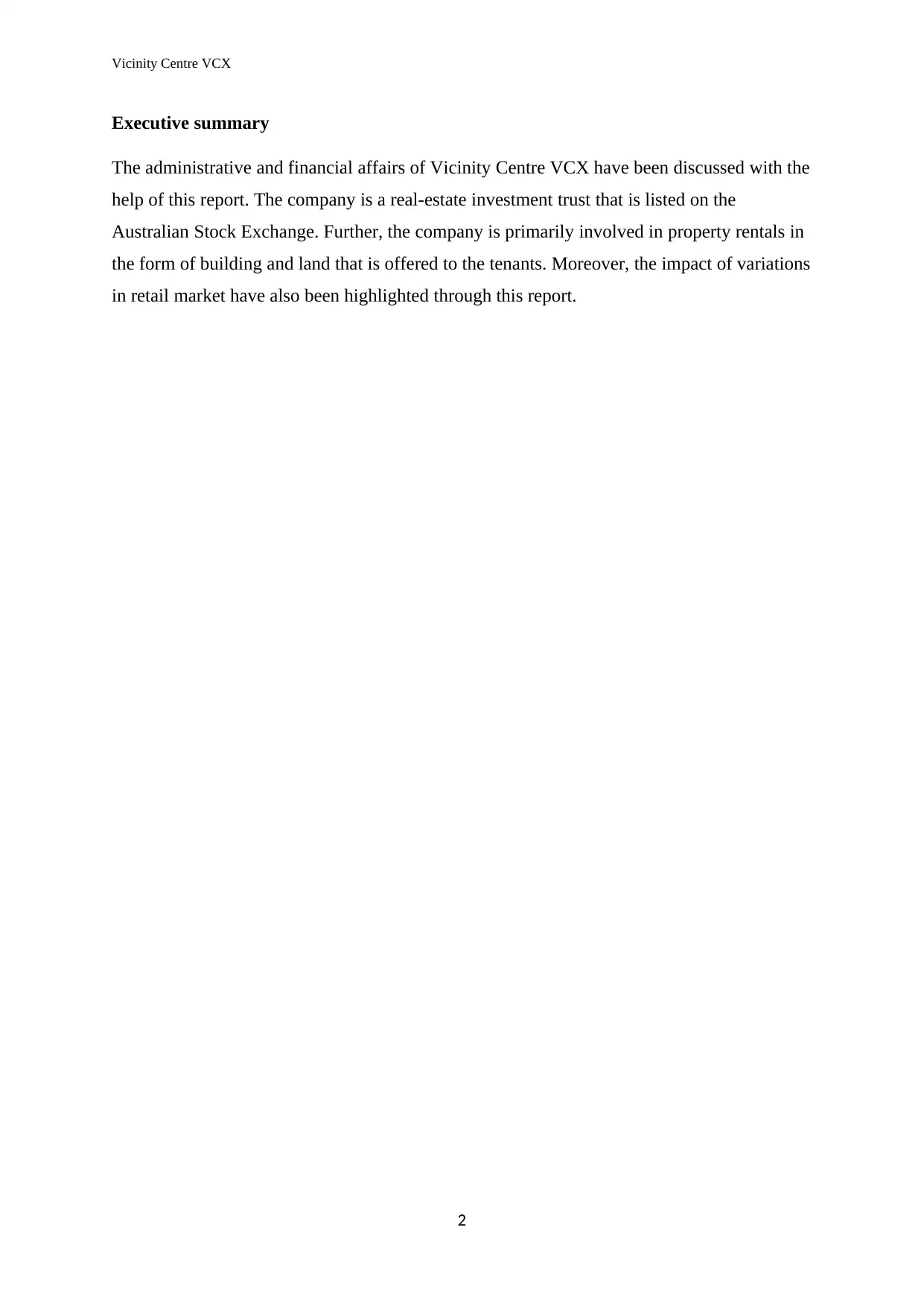
Vicinity Centre VCX
Executive summary
The administrative and financial affairs of Vicinity Centre VCX have been discussed with the
help of this report. The company is a real-estate investment trust that is listed on the
Australian Stock Exchange. Further, the company is primarily involved in property rentals in
the form of building and land that is offered to the tenants. Moreover, the impact of variations
in retail market have also been highlighted through this report.
2
Executive summary
The administrative and financial affairs of Vicinity Centre VCX have been discussed with the
help of this report. The company is a real-estate investment trust that is listed on the
Australian Stock Exchange. Further, the company is primarily involved in property rentals in
the form of building and land that is offered to the tenants. Moreover, the impact of variations
in retail market have also been highlighted through this report.
2
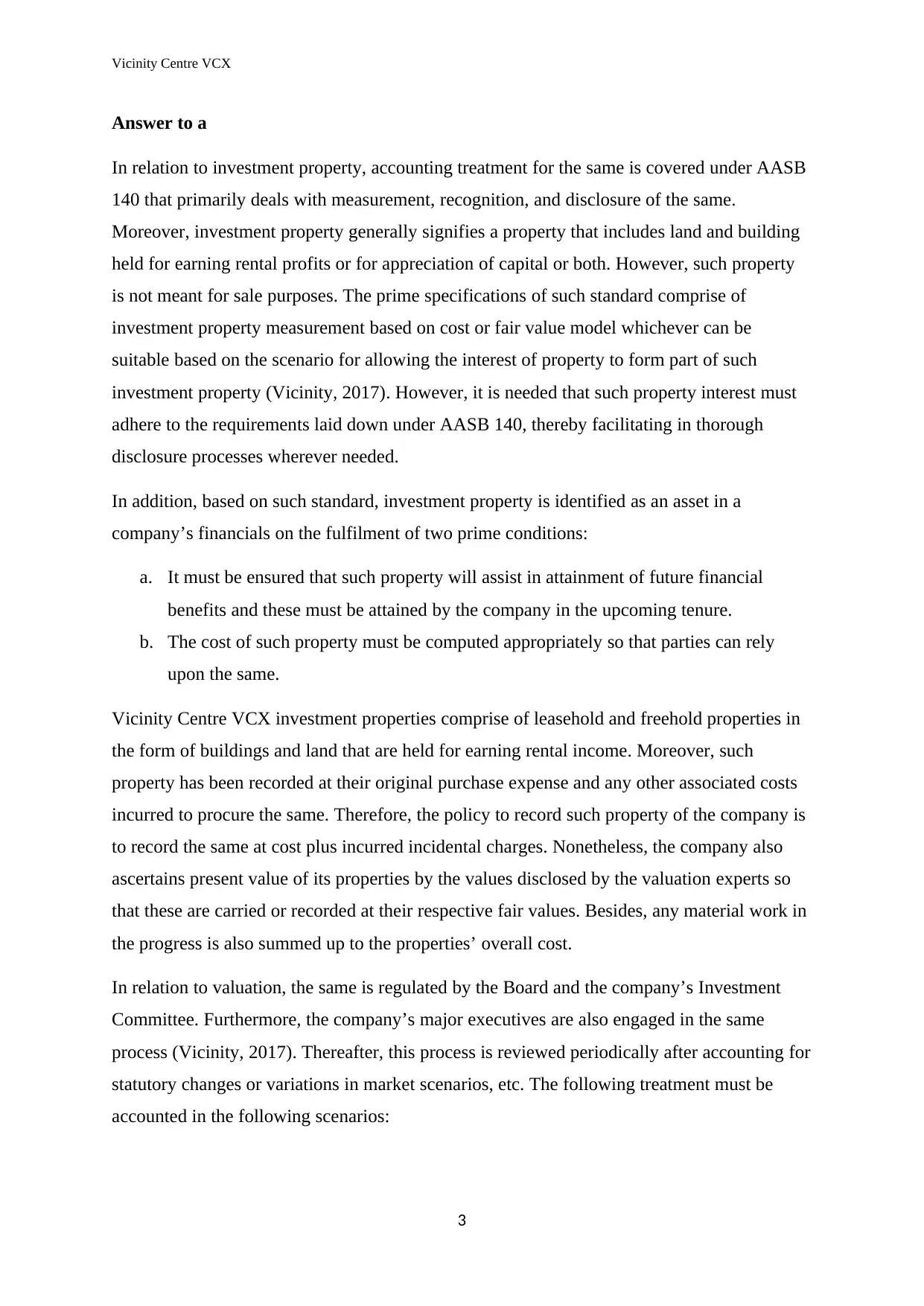
Vicinity Centre VCX
Answer to a
In relation to investment property, accounting treatment for the same is covered under AASB
140 that primarily deals with measurement, recognition, and disclosure of the same.
Moreover, investment property generally signifies a property that includes land and building
held for earning rental profits or for appreciation of capital or both. However, such property
is not meant for sale purposes. The prime specifications of such standard comprise of
investment property measurement based on cost or fair value model whichever can be
suitable based on the scenario for allowing the interest of property to form part of such
investment property (Vicinity, 2017). However, it is needed that such property interest must
adhere to the requirements laid down under AASB 140, thereby facilitating in thorough
disclosure processes wherever needed.
In addition, based on such standard, investment property is identified as an asset in a
company’s financials on the fulfilment of two prime conditions:
a. It must be ensured that such property will assist in attainment of future financial
benefits and these must be attained by the company in the upcoming tenure.
b. The cost of such property must be computed appropriately so that parties can rely
upon the same.
Vicinity Centre VCX investment properties comprise of leasehold and freehold properties in
the form of buildings and land that are held for earning rental income. Moreover, such
property has been recorded at their original purchase expense and any other associated costs
incurred to procure the same. Therefore, the policy to record such property of the company is
to record the same at cost plus incurred incidental charges. Nonetheless, the company also
ascertains present value of its properties by the values disclosed by the valuation experts so
that these are carried or recorded at their respective fair values. Besides, any material work in
the progress is also summed up to the properties’ overall cost.
In relation to valuation, the same is regulated by the Board and the company’s Investment
Committee. Furthermore, the company’s major executives are also engaged in the same
process (Vicinity, 2017). Thereafter, this process is reviewed periodically after accounting for
statutory changes or variations in market scenarios, etc. The following treatment must be
accounted in the following scenarios:
3
Answer to a
In relation to investment property, accounting treatment for the same is covered under AASB
140 that primarily deals with measurement, recognition, and disclosure of the same.
Moreover, investment property generally signifies a property that includes land and building
held for earning rental profits or for appreciation of capital or both. However, such property
is not meant for sale purposes. The prime specifications of such standard comprise of
investment property measurement based on cost or fair value model whichever can be
suitable based on the scenario for allowing the interest of property to form part of such
investment property (Vicinity, 2017). However, it is needed that such property interest must
adhere to the requirements laid down under AASB 140, thereby facilitating in thorough
disclosure processes wherever needed.
In addition, based on such standard, investment property is identified as an asset in a
company’s financials on the fulfilment of two prime conditions:
a. It must be ensured that such property will assist in attainment of future financial
benefits and these must be attained by the company in the upcoming tenure.
b. The cost of such property must be computed appropriately so that parties can rely
upon the same.
Vicinity Centre VCX investment properties comprise of leasehold and freehold properties in
the form of buildings and land that are held for earning rental income. Moreover, such
property has been recorded at their original purchase expense and any other associated costs
incurred to procure the same. Therefore, the policy to record such property of the company is
to record the same at cost plus incurred incidental charges. Nonetheless, the company also
ascertains present value of its properties by the values disclosed by the valuation experts so
that these are carried or recorded at their respective fair values. Besides, any material work in
the progress is also summed up to the properties’ overall cost.
In relation to valuation, the same is regulated by the Board and the company’s Investment
Committee. Furthermore, the company’s major executives are also engaged in the same
process (Vicinity, 2017). Thereafter, this process is reviewed periodically after accounting for
statutory changes or variations in market scenarios, etc. The following treatment must be
accounted in the following scenarios:
3
⊘ This is a preview!⊘
Do you want full access?
Subscribe today to unlock all pages.

Trusted by 1+ million students worldwide
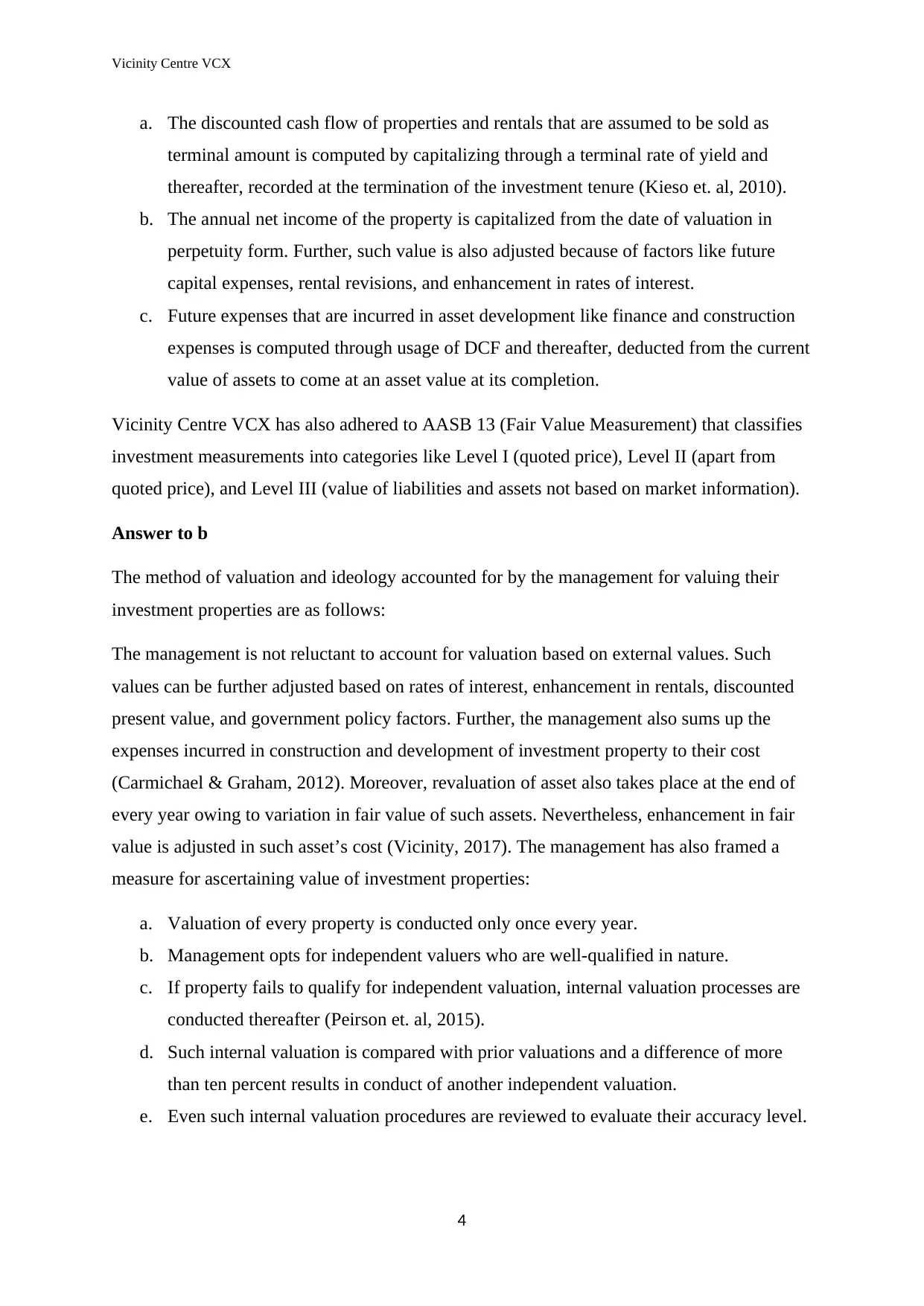
Vicinity Centre VCX
a. The discounted cash flow of properties and rentals that are assumed to be sold as
terminal amount is computed by capitalizing through a terminal rate of yield and
thereafter, recorded at the termination of the investment tenure (Kieso et. al, 2010).
b. The annual net income of the property is capitalized from the date of valuation in
perpetuity form. Further, such value is also adjusted because of factors like future
capital expenses, rental revisions, and enhancement in rates of interest.
c. Future expenses that are incurred in asset development like finance and construction
expenses is computed through usage of DCF and thereafter, deducted from the current
value of assets to come at an asset value at its completion.
Vicinity Centre VCX has also adhered to AASB 13 (Fair Value Measurement) that classifies
investment measurements into categories like Level I (quoted price), Level II (apart from
quoted price), and Level III (value of liabilities and assets not based on market information).
Answer to b
The method of valuation and ideology accounted for by the management for valuing their
investment properties are as follows:
The management is not reluctant to account for valuation based on external values. Such
values can be further adjusted based on rates of interest, enhancement in rentals, discounted
present value, and government policy factors. Further, the management also sums up the
expenses incurred in construction and development of investment property to their cost
(Carmichael & Graham, 2012). Moreover, revaluation of asset also takes place at the end of
every year owing to variation in fair value of such assets. Nevertheless, enhancement in fair
value is adjusted in such asset’s cost (Vicinity, 2017). The management has also framed a
measure for ascertaining value of investment properties:
a. Valuation of every property is conducted only once every year.
b. Management opts for independent valuers who are well-qualified in nature.
c. If property fails to qualify for independent valuation, internal valuation processes are
conducted thereafter (Peirson et. al, 2015).
d. Such internal valuation is compared with prior valuations and a difference of more
than ten percent results in conduct of another independent valuation.
e. Even such internal valuation procedures are reviewed to evaluate their accuracy level.
4
a. The discounted cash flow of properties and rentals that are assumed to be sold as
terminal amount is computed by capitalizing through a terminal rate of yield and
thereafter, recorded at the termination of the investment tenure (Kieso et. al, 2010).
b. The annual net income of the property is capitalized from the date of valuation in
perpetuity form. Further, such value is also adjusted because of factors like future
capital expenses, rental revisions, and enhancement in rates of interest.
c. Future expenses that are incurred in asset development like finance and construction
expenses is computed through usage of DCF and thereafter, deducted from the current
value of assets to come at an asset value at its completion.
Vicinity Centre VCX has also adhered to AASB 13 (Fair Value Measurement) that classifies
investment measurements into categories like Level I (quoted price), Level II (apart from
quoted price), and Level III (value of liabilities and assets not based on market information).
Answer to b
The method of valuation and ideology accounted for by the management for valuing their
investment properties are as follows:
The management is not reluctant to account for valuation based on external values. Such
values can be further adjusted based on rates of interest, enhancement in rentals, discounted
present value, and government policy factors. Further, the management also sums up the
expenses incurred in construction and development of investment property to their cost
(Carmichael & Graham, 2012). Moreover, revaluation of asset also takes place at the end of
every year owing to variation in fair value of such assets. Nevertheless, enhancement in fair
value is adjusted in such asset’s cost (Vicinity, 2017). The management has also framed a
measure for ascertaining value of investment properties:
a. Valuation of every property is conducted only once every year.
b. Management opts for independent valuers who are well-qualified in nature.
c. If property fails to qualify for independent valuation, internal valuation processes are
conducted thereafter (Peirson et. al, 2015).
d. Such internal valuation is compared with prior valuations and a difference of more
than ten percent results in conduct of another independent valuation.
e. Even such internal valuation procedures are reviewed to evaluate their accuracy level.
4
Paraphrase This Document
Need a fresh take? Get an instant paraphrase of this document with our AI Paraphraser
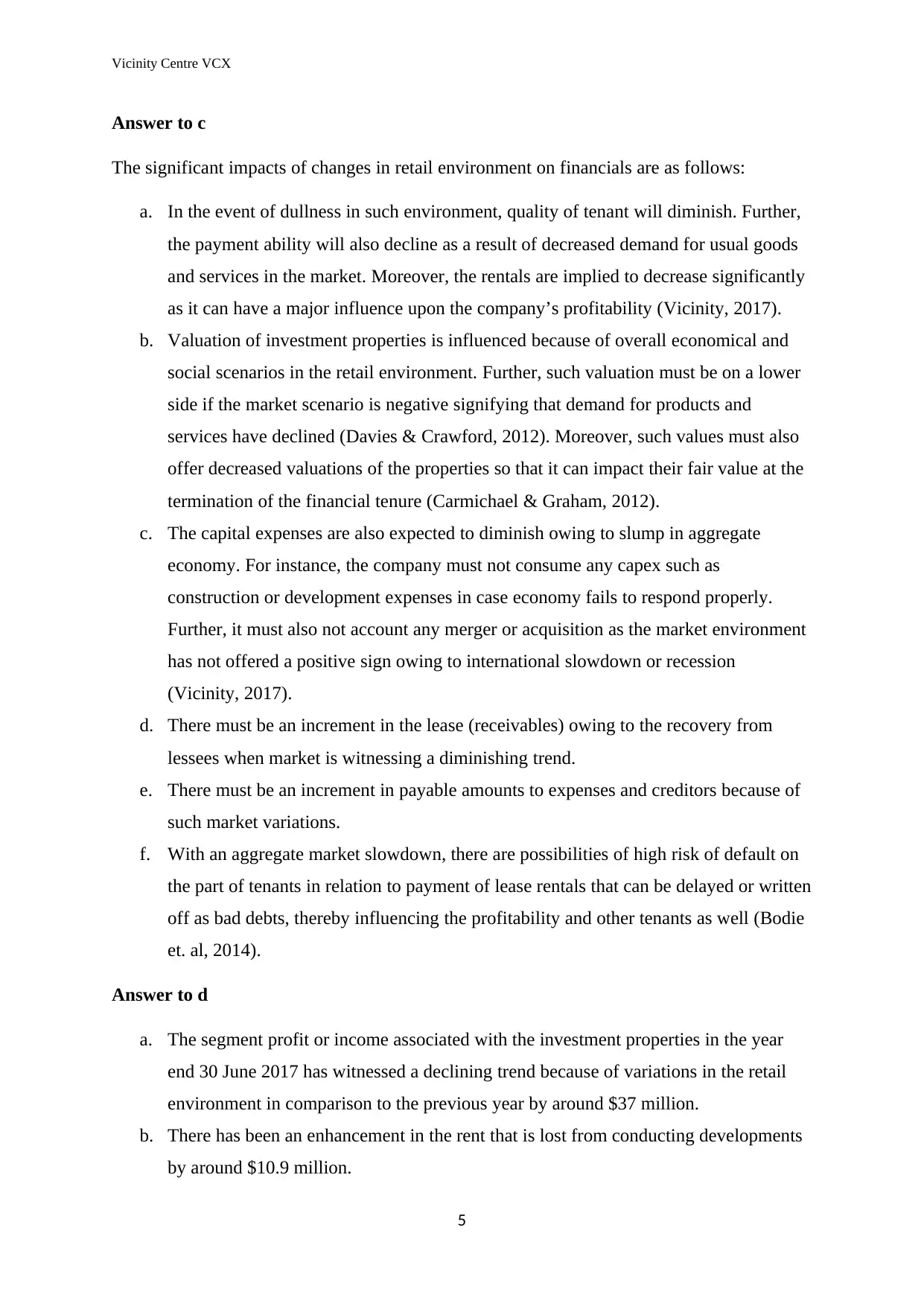
Vicinity Centre VCX
Answer to c
The significant impacts of changes in retail environment on financials are as follows:
a. In the event of dullness in such environment, quality of tenant will diminish. Further,
the payment ability will also decline as a result of decreased demand for usual goods
and services in the market. Moreover, the rentals are implied to decrease significantly
as it can have a major influence upon the company’s profitability (Vicinity, 2017).
b. Valuation of investment properties is influenced because of overall economical and
social scenarios in the retail environment. Further, such valuation must be on a lower
side if the market scenario is negative signifying that demand for products and
services have declined (Davies & Crawford, 2012). Moreover, such values must also
offer decreased valuations of the properties so that it can impact their fair value at the
termination of the financial tenure (Carmichael & Graham, 2012).
c. The capital expenses are also expected to diminish owing to slump in aggregate
economy. For instance, the company must not consume any capex such as
construction or development expenses in case economy fails to respond properly.
Further, it must also not account any merger or acquisition as the market environment
has not offered a positive sign owing to international slowdown or recession
(Vicinity, 2017).
d. There must be an increment in the lease (receivables) owing to the recovery from
lessees when market is witnessing a diminishing trend.
e. There must be an increment in payable amounts to expenses and creditors because of
such market variations.
f. With an aggregate market slowdown, there are possibilities of high risk of default on
the part of tenants in relation to payment of lease rentals that can be delayed or written
off as bad debts, thereby influencing the profitability and other tenants as well (Bodie
et. al, 2014).
Answer to d
a. The segment profit or income associated with the investment properties in the year
end 30 June 2017 has witnessed a declining trend because of variations in the retail
environment in comparison to the previous year by around $37 million.
b. There has been an enhancement in the rent that is lost from conducting developments
by around $10.9 million.
5
Answer to c
The significant impacts of changes in retail environment on financials are as follows:
a. In the event of dullness in such environment, quality of tenant will diminish. Further,
the payment ability will also decline as a result of decreased demand for usual goods
and services in the market. Moreover, the rentals are implied to decrease significantly
as it can have a major influence upon the company’s profitability (Vicinity, 2017).
b. Valuation of investment properties is influenced because of overall economical and
social scenarios in the retail environment. Further, such valuation must be on a lower
side if the market scenario is negative signifying that demand for products and
services have declined (Davies & Crawford, 2012). Moreover, such values must also
offer decreased valuations of the properties so that it can impact their fair value at the
termination of the financial tenure (Carmichael & Graham, 2012).
c. The capital expenses are also expected to diminish owing to slump in aggregate
economy. For instance, the company must not consume any capex such as
construction or development expenses in case economy fails to respond properly.
Further, it must also not account any merger or acquisition as the market environment
has not offered a positive sign owing to international slowdown or recession
(Vicinity, 2017).
d. There must be an increment in the lease (receivables) owing to the recovery from
lessees when market is witnessing a diminishing trend.
e. There must be an increment in payable amounts to expenses and creditors because of
such market variations.
f. With an aggregate market slowdown, there are possibilities of high risk of default on
the part of tenants in relation to payment of lease rentals that can be delayed or written
off as bad debts, thereby influencing the profitability and other tenants as well (Bodie
et. al, 2014).
Answer to d
a. The segment profit or income associated with the investment properties in the year
end 30 June 2017 has witnessed a declining trend because of variations in the retail
environment in comparison to the previous year by around $37 million.
b. There has been an enhancement in the rent that is lost from conducting developments
by around $10.9 million.
5
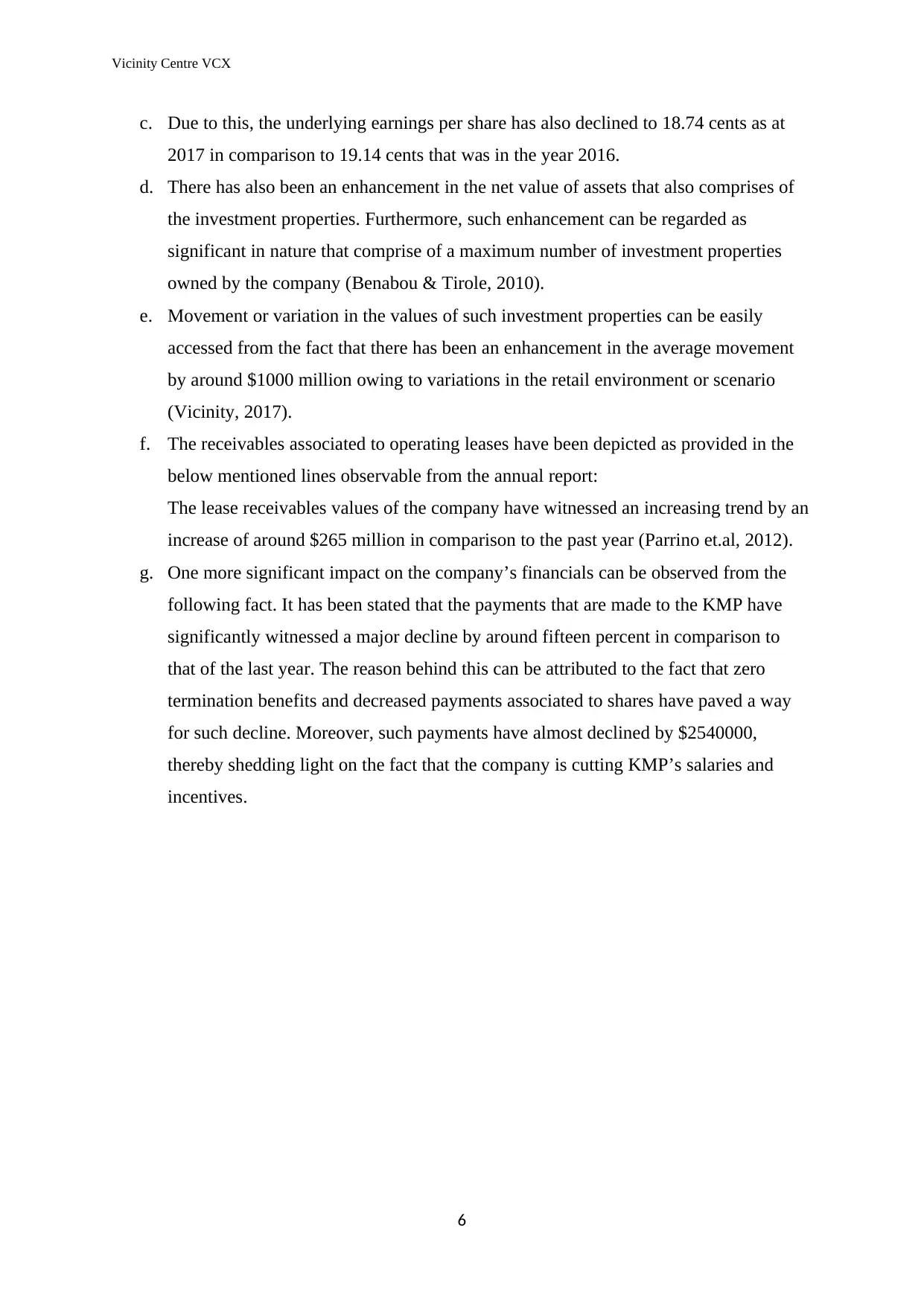
Vicinity Centre VCX
c. Due to this, the underlying earnings per share has also declined to 18.74 cents as at
2017 in comparison to 19.14 cents that was in the year 2016.
d. There has also been an enhancement in the net value of assets that also comprises of
the investment properties. Furthermore, such enhancement can be regarded as
significant in nature that comprise of a maximum number of investment properties
owned by the company (Benabou & Tirole, 2010).
e. Movement or variation in the values of such investment properties can be easily
accessed from the fact that there has been an enhancement in the average movement
by around $1000 million owing to variations in the retail environment or scenario
(Vicinity, 2017).
f. The receivables associated to operating leases have been depicted as provided in the
below mentioned lines observable from the annual report:
The lease receivables values of the company have witnessed an increasing trend by an
increase of around $265 million in comparison to the past year (Parrino et.al, 2012).
g. One more significant impact on the company’s financials can be observed from the
following fact. It has been stated that the payments that are made to the KMP have
significantly witnessed a major decline by around fifteen percent in comparison to
that of the last year. The reason behind this can be attributed to the fact that zero
termination benefits and decreased payments associated to shares have paved a way
for such decline. Moreover, such payments have almost declined by $2540000,
thereby shedding light on the fact that the company is cutting KMP’s salaries and
incentives.
6
c. Due to this, the underlying earnings per share has also declined to 18.74 cents as at
2017 in comparison to 19.14 cents that was in the year 2016.
d. There has also been an enhancement in the net value of assets that also comprises of
the investment properties. Furthermore, such enhancement can be regarded as
significant in nature that comprise of a maximum number of investment properties
owned by the company (Benabou & Tirole, 2010).
e. Movement or variation in the values of such investment properties can be easily
accessed from the fact that there has been an enhancement in the average movement
by around $1000 million owing to variations in the retail environment or scenario
(Vicinity, 2017).
f. The receivables associated to operating leases have been depicted as provided in the
below mentioned lines observable from the annual report:
The lease receivables values of the company have witnessed an increasing trend by an
increase of around $265 million in comparison to the past year (Parrino et.al, 2012).
g. One more significant impact on the company’s financials can be observed from the
following fact. It has been stated that the payments that are made to the KMP have
significantly witnessed a major decline by around fifteen percent in comparison to
that of the last year. The reason behind this can be attributed to the fact that zero
termination benefits and decreased payments associated to shares have paved a way
for such decline. Moreover, such payments have almost declined by $2540000,
thereby shedding light on the fact that the company is cutting KMP’s salaries and
incentives.
6
⊘ This is a preview!⊘
Do you want full access?
Subscribe today to unlock all pages.

Trusted by 1+ million students worldwide
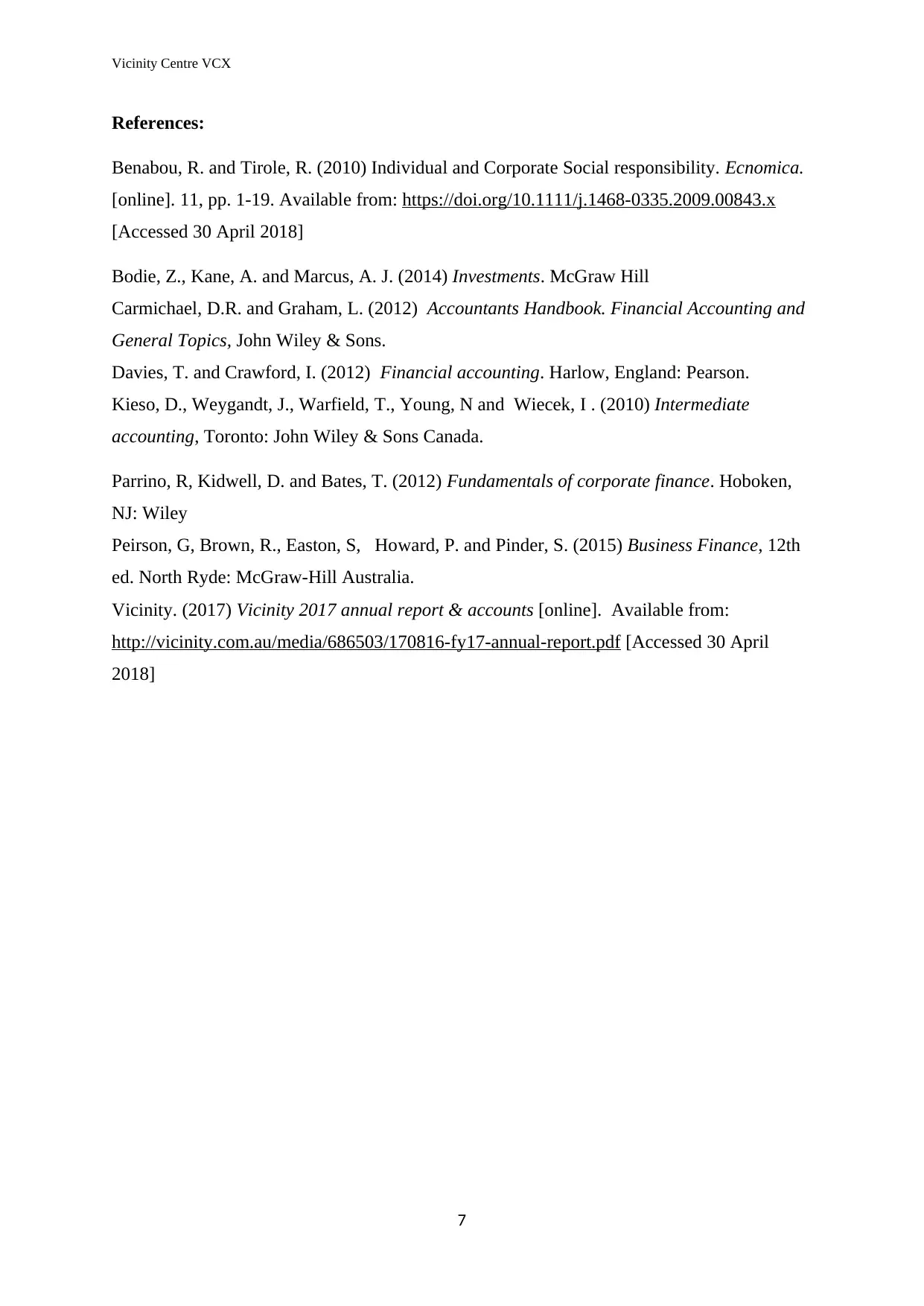
Vicinity Centre VCX
References:
Benabou, R. and Tirole, R. (2010) Individual and Corporate Social responsibility. Ecnomica.
[online]. 11, pp. 1-19. Available from: https://doi.org/10.1111/j.1468-0335.2009.00843.x
[Accessed 30 April 2018]
Bodie, Z., Kane, A. and Marcus, A. J. (2014) Investments. McGraw Hill
Carmichael, D.R. and Graham, L. (2012) Accountants Handbook. Financial Accounting and
General Topics, John Wiley & Sons.
Davies, T. and Crawford, I. (2012) Financial accounting. Harlow, England: Pearson.
Kieso, D., Weygandt, J., Warfield, T., Young, N and Wiecek, I . (2010) Intermediate
accounting, Toronto: John Wiley & Sons Canada.
Parrino, R, Kidwell, D. and Bates, T. (2012) Fundamentals of corporate finance. Hoboken,
NJ: Wiley
Peirson, G, Brown, R., Easton, S, Howard, P. and Pinder, S. (2015) Business Finance, 12th
ed. North Ryde: McGraw-Hill Australia.
Vicinity. (2017) Vicinity 2017 annual report & accounts [online]. Available from:
http://vicinity.com.au/media/686503/170816-fy17-annual-report.pdf [Accessed 30 April
2018]
7
References:
Benabou, R. and Tirole, R. (2010) Individual and Corporate Social responsibility. Ecnomica.
[online]. 11, pp. 1-19. Available from: https://doi.org/10.1111/j.1468-0335.2009.00843.x
[Accessed 30 April 2018]
Bodie, Z., Kane, A. and Marcus, A. J. (2014) Investments. McGraw Hill
Carmichael, D.R. and Graham, L. (2012) Accountants Handbook. Financial Accounting and
General Topics, John Wiley & Sons.
Davies, T. and Crawford, I. (2012) Financial accounting. Harlow, England: Pearson.
Kieso, D., Weygandt, J., Warfield, T., Young, N and Wiecek, I . (2010) Intermediate
accounting, Toronto: John Wiley & Sons Canada.
Parrino, R, Kidwell, D. and Bates, T. (2012) Fundamentals of corporate finance. Hoboken,
NJ: Wiley
Peirson, G, Brown, R., Easton, S, Howard, P. and Pinder, S. (2015) Business Finance, 12th
ed. North Ryde: McGraw-Hill Australia.
Vicinity. (2017) Vicinity 2017 annual report & accounts [online]. Available from:
http://vicinity.com.au/media/686503/170816-fy17-annual-report.pdf [Accessed 30 April
2018]
7
1 out of 7
Related Documents
Your All-in-One AI-Powered Toolkit for Academic Success.
+13062052269
info@desklib.com
Available 24*7 on WhatsApp / Email
![[object Object]](/_next/static/media/star-bottom.7253800d.svg)
Unlock your academic potential
Copyright © 2020–2025 A2Z Services. All Rights Reserved. Developed and managed by ZUCOL.





